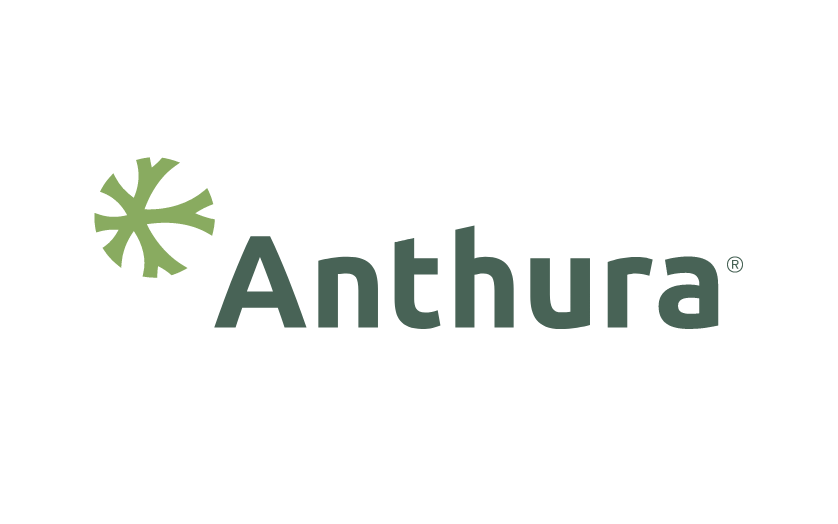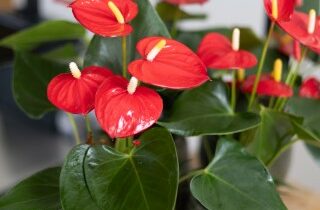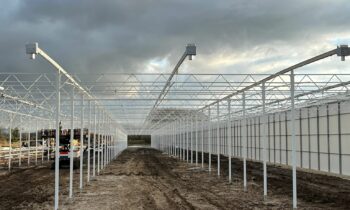The quality of a plant depends on the correct use of the right substrate with the right properties. If you stop to think about it, you immediately realize that one substrate is not the same as another. Not only is there a lot involved in developing the right composition, consistent production and learning to use it correctly are important aspects when using substrate.
Anthurium cultivation generally involves the use of what are known as ‘airy substrates’. These are substrates that contain a lot of air, even in humid conditions. These substrates now often consist of a high proportion of peat supplemented by other raw materials. These are substrates for which a lot of experience and knowledge are readily available. Substrates can contain a variety of raw materials. The crop and your ultimate needs and objectives are what determine which elements and their corresponding properties are important for the substrate to be used.
– Airy: because Anthurium is an epiphyte, it is important that there is enough air in the substrate so the roots do not remain wet for long after watering.
– Stability: Anthurium cut flower plants usually last around 6-7 years and during that time the substrate must remain in a good condition. It should not rot, disintegrate and/or smother/settle quickly.
– Salt levels: the substrate should not contain high levels of sodium (<3.0 mmol), chlorine (<3.0 mmol), or heavy metals. – Deformable: the root must be given space in the substrate. Heavy stones present a physical barrier to root development.

Difference in root development: lava on the left, perlite on the right.
Organic and inorganic media
Inorganic media remain virtually intact during cultivation. Examples include polyphenol foam, lava, charcoal and rock wool. However, root growth also affects these media through:
– Physical degradation Roots cause the physical breakdown of the substrate. As they grow through the substrate, the original faction reduces in size over time.
– PH influence The pH can affect the structure of different substrates over time.
In addition to the above factors, organic substrates also concern digestion by micro-organisms. Examples are turf and coconut pellets. In Europe, these substrates are not used. The rate of decomposition is highly dependent on humidity. Wet cultivation on organic substrates greatly accelerates decomposition. In many cases, a dense layer forms on the soil within a short time after cultivation, causing the roots to die. The use of inorganic substrates is strongly preferred.
Physical properties
The capillarity of the substrate determines to a large extent what kind of watering system is necessary. Lava pellets are barely capillary, so lots of drip points and/or a sprinkler system are important.
Buffer
Inorganic substrates have little possibility to store fertilizers, so a good water and nutrition system is of great importance.
Environment
For some inorganic substrates, there is no possibility for reuse or recycling after cultivation.
Inorganic substrates
Polyphenol foam
Polyphenol foam has been used successfully as a growing medium for many years. In Europe, this waste product, in the form cubes of floral foam, is used in production and forms the cultivation medium. In Asia they often make their own cubes of floral foam. There is a lot of space between the polyphenol foam cubes, so air and roots like to grow around them. The cubes themselves contain hardly any air when saturated. After production, the material contains formaldehyde gas which is harmful to the crop. It is therefore very important to ‘gas out’ polyphenol foam for a considerable time before use. The pH is very low and therefore liming is always necessary. Use 1.5-2.5 kg Dolokal (± 90%CaCO₃) per cubic metre of polyphenol foam. Polyphenol foam should never be allowed to dry out, since it will only absorb water with great difficulty afterwards. Quality problems regularly occur with this substrate. It either turns out to contain harmful substances or have a different structure, which makes water absorption very difficult , or it contains a lot of dust, which increases the risk of smothering.
The capillarity of polyphenol foam is also disappointing because of its coarse structure. The use of a sprinkler system is therefore recommended.

Buffering of self-cut polyphenol foam.

To the left, good polyphenol foam; to the right, the wrong polyphenol foam.

Cultivation on polyphenol foam.
Rock wool
At Anthura, large cut Anthurium plants in the 9 cm pot size have been grown successfully on rock wool, Grodan Growcube 1x1x1 cm, for many years. Rock wool is also one of the best substrates in Anthurium cut flower cultivation, but it is expensive. Usually, cubes of 2x2x2 cm are used. A few years back, lack of product capillarity was the bottleneck. Nowadays this is in good order (if you choose the right supplier) and the substrate also remains sufficiently moist on top, so that the roots can develop well there. If a low pH (<3.0) develops during cultivation, the structure of the rock wool can break down and form a slushy layer.
At the start, the pH is usually above 6.5 and drops to a pH of 4-5 during cultivation, depending on the variety, starting water, irrigation strategy, and pH control.

Rock wool 2x2x2 cm cubes in W-gutter.
Perlite
The original glassy white rock has a density of about 1100 kg/m³. When heated to 850-900°C, it expands to twenty times its original volume. This is because at that temperature it begins to soften (after all, it is a glass) and the water present in the material forms a lot of tiny bubbles. In the process, large pores are formed. The end product is the grey-white perlite grain.
Despite its excellent capillary properties, perlite often remains somewhat dry at the start of cultivation. This is especially the case if only a drip line is used. Choose a coarse-fraction peat.

Perlite in pot.

Full rooting in perlite.
At the start, the drain pH is usually above 6.5 and after about six months of cultivation it drops to a pH of 4-5. The pH then drops further to around 3.0-3.3. This depends on the variety, starting water, irrigation strategy, and pH control.
Coconut pellets Coconut fiber is used as a substrate in the form of pellets. High salt content (NaCl) and poor buffering are particular concerns. If the product was sourced near the coast, it contains a lot of sodium. It is preferable for the product to be sourced from inland regions. The coconut pellets must be at least one year old before they can be used as a substrate. Rinsing A minimum of three rinses are usually required to remove excess salts from the material. Rinsing should be done with water with the lowest possible EC. The first two rinsing sessions should take at least 12 hours. After this session, you should measure the EC. If it is still too high (> 0.5 mS/cm), rinse again with clean water. The final rinsing session must be done with calcium nitrate CaNO₃ (15.5% N and 26.5% CaO, 1 gram per litre, EC ± 1.2). Then, 2 kg of Dolokal (± 90%CaCO₃) per cubic metre of substrate should be added.

Rinsing of coconut pellets.

Cultivation on coconut pellets.
Charcoal
Charcoal is a lightweight, black carbon residue produced by heating wood at a high temperature to remove all water and volatile components. This process takes place at a very low oxygen level. Of all organic substrates, this material has the longest lifespan. The water absorption capacity can be disappointing, the capillarity is low, and the Anthurium plants will mainly root around the substrate and not through it, as in the case of rock wool or coconut pellets. At the bottom of the bed, the charcoal will settle over time, creating a smothered layer. A lot of attention should be given to the correct distribution of the watering system.

Charcoal.
Perlite is a worldwide favourite
Inorganic substrates are clearly preferred for cut Anthurium cultivation. The cultivation gets its quickest start on rock wool. Nevertheless, in Europe and Canada perlite is by far the favourite growing medium, thanks to its wide availability and reasonable pricing. In China and Brazil, cultivation is mainly on polyphenol foam, in India on coconut pellets, and in Thailand on charcoal and coconut pellets.
Top layer and microclimate
At the start of cultivation on substrates with lower capillary action and when using only a dripsystem, the top layer can remain dry. This creates a dry microclimate which can make growth difficult, especially for small plants. Protecting the plants from extra light and watering them more often with a sprinkler head are recommended.

Two drippers due to capillarity.







